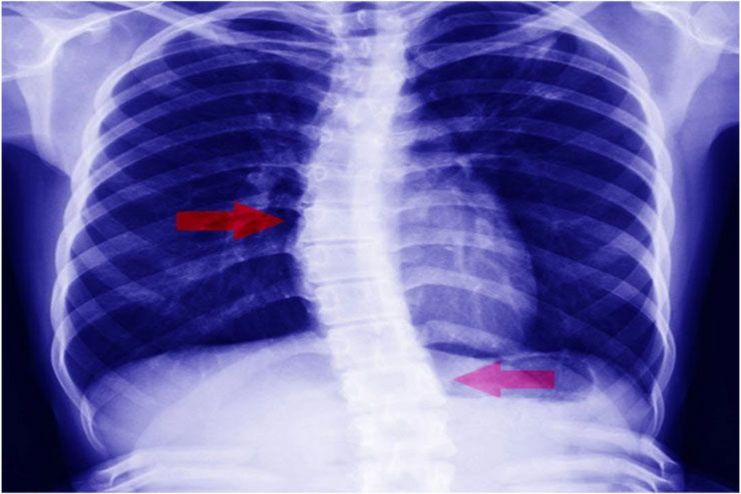Affiliate Disclaimer
Some links in this article are affiliate links. We may earn a small commission if you make a purchase through these links, at no extra cost to you. We only recommend products we find useful to our readersRibs are among the most important parts of the body, protecting the internal organs. Even minor discomfort in the ribs can seriously disrupt everyday activities. But what if the ribs break or get injured? How easy is it to deal with broken ribs? Read through this article to learn about broken ribs and how to manage them.
Broken ribs are caused by breaks or cracks in one or more ribs. Chest trauma, often resulting from a fall or accident, is a common cause.
- Cracked ribs are less dangerous than ribs that are broken into multiple pieces. If there is a jagged edge of a broken bone, it may impact major internal organs or blood vessels.
- While broken ribs usually heal on their own in a few months, pain management is the challenging part. During the healing period, it is also important to avoid lung complications.
Major Causes For Broken Ribs
Major causes include:
- Accidents such as falls
- Motor vehicle accidents
- Contact sports
- Physical abuse
- Repetitive trauma from rowing, golf, etc.
- Prolonged coughing
Symptoms of Broken Ribs
Pain is the major symptom, which worsens when you:
- Feel the pressure on the broken area
- Take deep breaths
- Twist or bend the ribs
If you can’t breathe normally because of your injuries, it may cause:
- Shortness of breath
- Anxiety, restlessness, or fear
- Headaches
- Feeling tired, dizzy, or sleepy
Risk Factors for Broken Rib Condition
The factors that increase the risk of rib fractures include:
- Osteoporosis: A disease in which bones lose density and become more susceptible to injuries.
- Sports participation: Contact sports like football, hockey, etc., increase the risk.
- Cancerous lesions: Cancerous lesions in the ribs weaken the bones, making them more susceptible to fractures.
Complications Linked with Broken Ribs
The two main jobs of your ribs include:
- Protecting organs in the chest
- Helping with breathing by keeping space inside your chest open, allowing your lungs to fill up with air
Broken ribs may injure internal organs as well as blood vessels. The greater the number of breaks, the higher the risk. Complications vary based on the location of the break and may include:
- Torn or punctured aorta: A break in one of the first three ribs may rupture a major blood vessel or the aorta.
- Lacerated spleen, liver, or kidneys: Broken lower ribs can cause serious damage to the kidneys, spleen, or liver.
- Punctured lung: A broken middle rib may puncture the lung.
How to Diagnose Broken Ribs?

Doctors diagnose broken ribs through a physical examination, such as gently pressing on the rib area. The physician may use a stethoscope to listen to your lungs or observe the movement of your rib cage while breathing. Your medical practitioner may request one or more imaging tests.
- X-Ray: X-rays make bones visible and help reveal fresh rib fractures caused by cracks. A collapsed lung can also be diagnosed using X-rays.
- Bone Scan: This scan helps view stress fractures, where the bone is cracked due to repetitive trauma. A small amount of radioactive material is injected into the bloodstream, collecting in areas where the bone is healing.
- CT Scan: This scan uncovers rib fractures that may be left unidentified by X-rays. It can also reveal injuries to blood vessels and soft tissues.
- MRI: MRI provides images of the organs and soft tissues surrounding the ribs. More subtle rib fractures can be identified, and magnetic and radio waves can produce cross-sectional images.
How to Prevent Broken Ribs?
Take preventive measures and avoid injuries or breaks in the ribs.
- Stay safe and protect yourself from athletic injuries and contact sports by wearing protective equipment. Avoid household fall risks by regularly removing clutter, keeping floors clear, using a rubber mat in the shower, cleaning spills immediately, and keeping your home well-lit.
- Strengthen your bones by consuming enough vitamin D and calcium. Maintain at least 1,200 mg of calcium and 600 IU of vitamin D in your daily diet.
Treatment for Broken Ribs
Restricting activities and rest help bones heal naturally. Icing also helps with pain relief and healing. Other treatment methods include medications and therapies.
Once the pain is under control, your doctor will suggest breathing exercises to improve deep breathing. Shallow breathing is associated with a higher risk of developing pneumonia.
Tips for Managing Broken Ribs
- Go for OTC painkillers for relief.
- Hold an ice pack against the broken rib area.
- Take time to rest.
- Breathe normally.
- Cough with a pillow against your chest.
- Try sleeping upright more.
- Do not tightly wrap or tape the injured rib area.
- Avoid it, even if it eases the pain.
When to Visit a Doctor?
Any pain in the chest area should not be neglected, and a doctor’s visit is a must, especially if you have experienced trauma to the chest area or feel pain while breathing deeply. Immediate medical attention is required if you:
- Feel fullness or pressure
- Experience squeezing pain in the center of the chest
- Notice the pain extending from the chest to the shoulder region
Your doctor may ask:
- When did the symptoms begin?
- Where is the pain?
- Are the symptoms occasional or continuous?
- Do you feel severe pain?
- What is the cause?
- Does any action improve or reduce the pain?
Conclusion
In a nutshell, broken ribs can be painful and disruptive but can heal on their own with appropriate care and enough rest. Try taking deep breaths at least once an hour during your recovery period. This will help prevent pneumonia or a partial lung tissue collapse. Lie on the injured side to easily take deep breaths.
Manage pain, follow recommended breathing exercises, and take preventive steps to avoid further injury to heal quickly and reduce complications. Practice safety measures in daily activities and sports to prevent rib injuries.
If injury occurs, promptly seek medical attention. With careful attention to symptoms, prompt treatment is possible. Make your recovery process smooth, leading back to regular activities quickly.
-
Jan 2018Written by Sumana Maheswari
-
Dec 2024Edited by Lakshmi Gayatri
In this Article

















